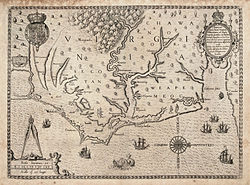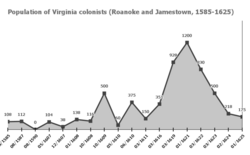Before 1606

- June 1561: Native Virginian Paquiquineo was kidnapped by the crew of the Spanish caravel Santa Catalina in Chesapeake Bay. Some historians believe Paquiquineo and Opechancanough are the same individual. [2]
- September 8, 1565: The Spanish Empire settled in St. Augustine, Florida and annexed parts of the Outer Banks, calling the region north to Delaware Bay "La Florida". [3]
- c. Feb 1571: Paquiquineo, now christened as "Don Luís de Velasco", slayed eight Jesuit missionaries attempting to set up Ajacán Mission. [4]
- c. 1585: Walter Raleigh was granted a charter by Queen Elizabeth I, naming the North American coast "Virginia" in tribute to her. This led to the establishment of a colony on Roanoke Island with 108 men. [5]
- August 18, 1590: John White and the Watts' expedition men discovered the Roanoke Colony abandoned.
- May – June 1602: Captain Bartholomew Gosnold, Captain Bartholomew Gilbert, Captain Gabriel Archer and others explored the New World coast with the intention of starting a colony, but occupied Cuttyhunk Island for only a few weeks before returning to England. [6]
- March 24, 1603: Queen Elizabeth I dies. James VI of Scotland becomes King James I of England.
- c. 1605: Chesapeake people were slain on the orders of Powhatan (Native American leader).[ citation needed ]











